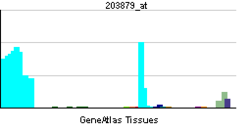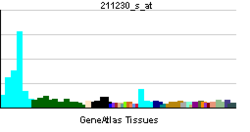- P110δ
-
Phosphatidylinositol-4,5-bisphosphate 3-kinase catalytic subunit delta isoform also known as phosphoinositide 3-kinase (PI3K) or p110δ is an enzyme that in humans is encoded by the PIK3CD gene.[1][2][3]
p110δ regulates immune function. In contrast to the other class IA PI3Ks p110α and p110β, p110δ is principally expressed in leukocytes (white blood cells). Genetic and pharmacological inactivation of p110δ has revealed that this enzymes is important for the function of T cells, B cell, mast cells and neutrophils. Hence, p110δ is consider to be a promising target for drugs that aim to prevent or treat inflammation and autoimmunity and transplant rejection.[4]
Phosphoinositide 3-kinases (PI3Ks) phosphorylate the 3-prime OH position of the inositol ring of inositol lipids. The class I PI3Ks display a broad phosphoinositide lipid substrate specificity and include p110α, p110β, and p110γ. p110α and p110β interact with SH2/SH3-domain-containing p85 adaptor proteins and with GTP-bound Ras.[3]
Contents
Biochemistry
Like the other class IA PI3Ks, p110δ is a catalytic subunit, whose activity and subcellular localisation are controlled by an associated p85α, p55α, p50α or p85β regulatory subunit. The p55γ regulatory subunit is not thought to be expressed at significant levels in immune cells. These is no evidence for selective association between p110α, p110β or p110δ for any particular regulatory subunit. The class IA regulatory subunits (collectively referred to here as p85) bind to proteins which have been phosphorylated on tyrosines. Tyrosine kinases often operate near the plasma membrane and hence control the recruitment of p110δ to the plasma membrane where it substrate PtdIns(4,5)P2 is found. The conversion of PtdIns(4,5)P2 to PtdIns(3,4,5)P3 triggers signal transduction cascades controlled by PKB (also known as Akt), Tec family kinases, and other proteins that contain PH domains. In immune cells, antigen receptors, cytokine receptors and costimulatory and accessory receptors stimulate tyrosine kinase activity and hence all have the potential to initiate PI3K signalling.[5][6]
Functions
For reasons that are not well understood, p110δ appears to be activated in preference to p110α and p110β in a number of immune cells. The following is a brief summary of the role of p110δ in selected leukocyte subsets.
T cells
In T cells, the antigen receptor (TCR) and costimulatory receptors (CD28 and ICOS) are thought to be main receptors responsible for recruiting and activating p110δ. Genetic inactivation of p110δ in mice causes T cells to be less responsive to antigen as determined by their reduced ability to proliferate and secrete interleukin 2. This may in part results from incomplete assembly of other signalling proteins at the immune synapse. The TCR cannot stimulate the phosphorylation of Akt in that absence of p110δ activity.[7]
B cells
p110δ is a key regulator of B cell proliferation and function. p110δ deficient mice have deficient antibody responses. They also lack to B cell subsets: B1 cells (found in body cavities such as the peritoneum) and marginal zone B cells, found in the periphery of spleen follicles).[7]
Mast cells
p110δ controls mast cell release of the granules responsible for allergic reactions. Thus inhibition of p110δ reduces allergic responses.[8]
Neutrophils
In conjunction with p110γ, p110δ controls the release of reactive oxygen species in neutrophils.[9]
Pharmacology
The US pharmaceutical company ICOS has produced a selective inhibitor of p110δ called IC87114. This inhibitor has been shown to selectively impair B cell, mast cell and neutrophil functions and is therefore a potential immune-modulator.[citation needed]
Another p110δ inhibitor is CAL101 which has reported good results from phase I clinical trials.[10]
Interactions
PIK3CD has been shown to interact with PIK3R1,[1] PIK3CG[1] and PIK3R2.[1]
See also
- Phosphoinositide 3-kinase inhibitor
References
- ^ a b c d Vanhaesebroeck B, Welham MJ, Kotani K, Stein R, Warne PH, Zvelebil MJ, Higashi K, Volinia S, Downward J, Waterfield MD (May 1997). "P110delta, a novel phosphoinositide 3-kinase in leukocytes". Proc Natl Acad Sci U S A 94 (9): 4330–5. doi:10.1073/pnas.94.9.4330. PMC 20722. PMID 9113989. http://www.pubmedcentral.nih.gov/articlerender.fcgi?tool=pmcentrez&artid=20722.
- ^ Seki N, Nimura Y, Ohira M, Saito T, Ichimiya S, Nomura N, Nakagawara A (Feb 1998). "Identification and chromosome assignment of a human gene encoding a novel phosphatidylinositol-3 kinase". DNA Res 4 (5): 355–8. doi:10.1093/dnares/4.5.355. PMID 9455486.
- ^ a b "Entrez Gene: PIK3CD phosphoinositide-3-kinase, catalytic, delta polypeptide". http://www.ncbi.nlm.nih.gov/sites/entrez?Db=gene&Cmd=ShowDetailView&TermToSearch=5293.
- ^ Harris SJ, Foster JG, Ward SG (November 2009). "PI3K isoforms as drug targets in inflammatory diseases: lessons from pharmacological and genetic strategies". Curr Opin Investig Drugs 10 (11): 1151–62. PMID 19876783.
- ^ Okkenhaug K, Vanhaesebroeck B (April 2003). "PI3K in lymphocyte development, differentiation and activation". Nat. Rev. Immunol. 3 (4): 317–30. doi:10.1038/nri1056. PMID 12669022.
- ^ Deane JA, Fruman DA (2004). "Phosphoinositide 3-kinase: diverse roles in immune cell activation". Annu. Rev. Immunol. 22: 563–98. doi:10.1146/annurev.immunol.22.012703.104721. PMID 15032589.
- ^ a b Okkenhaug K, Bilancio A, Farjot G, Priddle H, Sancho S, Peskett E, Pearce W, Meek SE, Salpekar A, Waterfield MD, Smith AJ, Vanhaesebroeck B (August 2002). "Impaired B and T cell antigen receptor signaling in p110delta PI 3-kinase mutant mice". Science 297 (5583): 1031–4. doi:10.1126/science.1073560. PMID 12130661.
- ^ Ali K, Bilancio A, Thomas M, Pearce W, Gilfillan AM, Tkaczyk C, Kuehn N, Gray A, Giddings J, Peskett E, Fox R, Bruce I, Walker C, Sawyer C, Okkenhaug K, Finan P, Vanhaesebroeck B (October 2004). "Essential role for the p110delta phosphoinositide 3-kinase in the allergic response". Nature 431 (7011): 1007–11. doi:10.1038/nature02991. PMID 15496927.
- ^ Condliffe AM, Davidson K, Anderson KE, Ellson CD, Crabbe T, Okkenhaug K, Vanhaesebroeck B, Turner M, Webb L, Wymann MP, Hirsch E, Ruckle T, Camps M, Rommel C, Jackson SP, Chilvers ER, Stephens LR, Hawkins PT (August 2005). "Sequential activation of class IB and class IA PI3K is important for the primed respiratory burst of human but not murine neutrophils". Blood 106 (4): 1432–40. doi:10.1182/blood-2005-03-0944. PMID 15878979.
- ^ "Calistoga Pharmaceuticals presents CAL-101 PI3K inhibitor data at European Hematology Association Congress". News-Medical.Net. 2010-06 -14. http://www.news-medical.net/news/20100614/Calistoga-Pharmaceuticals-presents-CAL-101-PI3K-inhibitor-data-at-European-Hematology-Association-Congress.aspx.
Further reading
- Lee C, Liu QH, Tomkowicz B, et al. (2004). "Macrophage activation through CCR5- and CXCR4-mediated gp120-elicited signaling pathways.". J. Leukoc. Biol. 74 (5): 676–82. doi:10.1189/jlb.0503206. PMID 12960231.
- Rommel C, Camps M, Ji H (2007). "PI3K delta and PI3K gamma: partners in crime in inflammation in rheumatoid arthritis and beyond?". Nat. Rev. Immunol. 7 (3): 191–201. doi:10.1038/nri2036. PMID 17290298.
- Milani D, Mazzoni M, Borgatti P, et al. (1996). "Extracellular human immunodeficiency virus type-1 Tat protein activates phosphatidylinositol 3-kinase in PC12 neuronal cells.". J. Biol. Chem. 271 (38): 22961–4. doi:10.1074/jbc.271.38.22961. PMID 8798481.
- Hillier LD, Lennon G, Becker M, et al. (1997). "Generation and analysis of 280,000 human expressed sequence tags.". Genome Res. 6 (9): 807–28. doi:10.1101/gr.6.9.807. PMID 8889549.
- Chantry D, Vojtek A, Kashishian A, et al. (1997). "p110delta, a novel phosphatidylinositol 3-kinase catalytic subunit that associates with p85 and is expressed predominantly in leukocytes.". J. Biol. Chem. 272 (31): 19236–41. doi:10.1074/jbc.272.31.19236. PMID 9235916.
- Mazerolles F, Barbat C, Fischer A (1997). "Down-regulation of LFA-1-mediated T cell adhesion induced by the HIV envelope glycoprotein gp160 requires phosphatidylinositol-3-kinase activity.". Eur. J. Immunol. 27 (9): 2457–65. doi:10.1002/eji.1830270946. PMID 9341793.
- Borgatti P, Zauli G, Colamussi ML, et al. (1998). "Extracellular HIV-1 Tat protein activates phosphatidylinositol 3- and Akt/PKB kinases in CD4+ T lymphoblastoid Jurkat cells.". Eur. J. Immunol. 27 (11): 2805–11. doi:10.1002/eji.1830271110. PMID 9394803.
- Borgatti P, Zauli G, Cantley LC, Capitani S (1998). "Extracellular HIV-1 Tat protein induces a rapid and selective activation of protein kinase C (PKC)-alpha, and -epsilon and -zeta isoforms in PC12 cells.". Biochem. Biophys. Res. Commun. 242 (2): 332–7. doi:10.1006/bbrc.1997.7877. PMID 9446795.
- Milani D, Mazzoni M, Zauli G, et al. (1998). "HIV-1 Tat induces tyrosine phosphorylation of p125FAK and its association with phosphoinositide 3-kinase in PC12 cells.". AIDS 12 (11): 1275–84. doi:10.1097/00002030-199811000-00008. PMID 9708406.
- Jauliac S, Mazerolles F, Jabado N, et al. (1998). "Ligands of CD4 inhibit the association of phospholipase Cgamma1 with phosphoinositide 3 kinase in T cells: regulation of this association by the phosphoinositide 3 kinase activity.". Eur. J. Immunol. 28 (10): 3183–91. doi:10.1002/(SICI)1521-4141(199810)28:10<3183::AID-IMMU3183>3.0.CO;2-A. PMID 9808187.
- Vanhaesebroeck B, Higashi K, Raven C, et al. (1999). "Autophosphorylation of p110delta phosphoinositide 3-kinase: a new paradigm for the regulation of lipid kinases in vitro and in vivo.". EMBO J. 18 (5): 1292–302. doi:10.1093/emboj/18.5.1292. PMC 1171219. PMID 10064595. http://www.pubmedcentral.nih.gov/articlerender.fcgi?tool=pmcentrez&artid=1171219.
- Park IW, Wang JF, Groopman JE (2001). "HIV-1 Tat promotes monocyte chemoattractant protein-1 secretion followed by transmigration of monocytes.". Blood 97 (2): 352–8. doi:10.1182/blood.V97.2.352. PMID 11154208.
- Zauli G, Milani D, Mirandola P, et al. (2001). "HIV-1 Tat protein down-regulates CREB transcription factor expression in PC12 neuronal cells through a phosphatidylinositol 3-kinase/AKT/cyclic nucleoside phosphodiesterase pathway.". FASEB J. 15 (2): 483–91. doi:10.1096/fj.00-0354com. PMID 11156964.
- Deregibus MC, Cantaluppi V, Doublier S, et al. (2002). "HIV-1-Tat protein activates phosphatidylinositol 3-kinase/ AKT-dependent survival pathways in Kaposi's sarcoma cells.". J. Biol. Chem. 277 (28): 25195–202. doi:10.1074/jbc.M200921200. PMID 11994280.
- Cook JA, August A, Henderson AJ (2002). "Recruitment of phosphatidylinositol 3-kinase to CD28 inhibits HIV transcription by a Tat-dependent mechanism.". J. Immunol. 169 (1): 254–60. PMID 12077252.
- Strausberg RL, Feingold EA, Grouse LH, et al. (2003). "Generation and initial analysis of more than 15,000 full-length human and mouse cDNA sequences.". Proc. Natl. Acad. Sci. U.S.A. 99 (26): 16899–903. doi:10.1073/pnas.242603899. PMC 139241. PMID 12477932. http://www.pubmedcentral.nih.gov/articlerender.fcgi?tool=pmcentrez&artid=139241.
- François F, Klotman ME (2003). "Phosphatidylinositol 3-kinase regulates human immunodeficiency virus type 1 replication following viral entry in primary CD4+ T lymphocytes and macrophages.". J. Virol. 77 (4): 2539–49. doi:10.1128/JVI.77.4.2539-2549.2003. PMC 141101. PMID 12551992. http://www.pubmedcentral.nih.gov/articlerender.fcgi?tool=pmcentrez&artid=141101.
- Sadhu C, Masinovsky B, Dick K, et al. (2003). "Essential role of phosphoinositide 3-kinase delta in neutrophil directional movement.". J. Immunol. 170 (5): 2647–54. PMID 12594293.
Categories:- Human proteins
- EC 2.7.1
- Immune system
Wikimedia Foundation. 2010.


